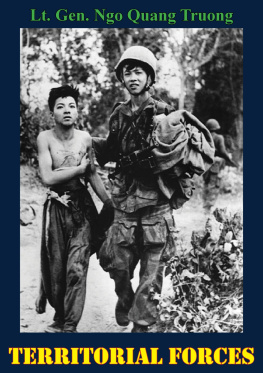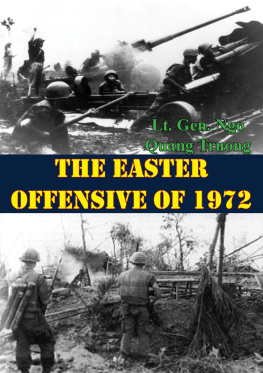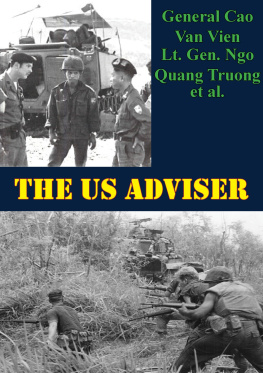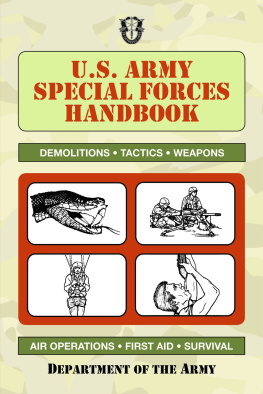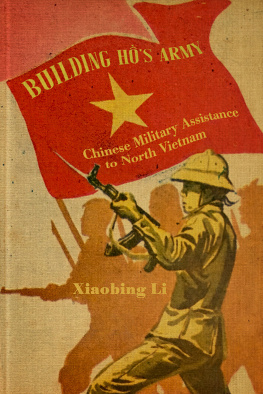

This edition is published by PICKLE PARTNERS PUBLISHINGwww.picklepartnerspublishing.com
To join our mailing list for new titles or for issues with our books picklepublishing@gmail.com
Or on Facebook
Text originally published in 1981 under the same title.
Pickle Partners Publishing 2015, all rights reserved. No part of this publication may be reproduced, stored in a retrieval system or transmitted by any means, electrical, mechanical or otherwise without the written permission of the copyright holder.
Publishers Note
Although in most cases we have retained the Authors original spelling and grammar to authentically reproduce the work of the Author and the original intent of such material, some additional notes and clarifications have been added for the modern readers benefit.
We have also made every effort to include all maps and illustrations of the original edition the limitations of formatting do not allow of including larger maps, we will upload as many of these maps as possible.
INDOCHINA MONOGRAPHS
TERRITORIAL FORCES
BY
LT. GEN. NGO QUANG TRUONG
TABLE OF CONTENTS
Contents
INTRODUCTION
This is one of a series published by the U.S. Army Center of Military History. They were written by officers who held responsible positions in the Cambodian, Laotian, and South Vietnamese armed forces during the war in Indochina. The General Research Corporation provided writing facilities and other necessary support under an Amy contract with the Center of Military History. The monographs were not edited or altered and reflect the views of their authorsnot necessarily those of the U.S. Amy or the Department of Defense. The authors were not attempting to write definitive accounts but to set down how they saw the war in Southeast Asia.
Colonel William E. Le Gro, U.S. Amy, retired, has written a forthcoming work allied with this series, Vietnam : From Cease-Fire to Capitulation . Another book, The Final Collapse by General Cao Van Vien, the last chairman of the South Vietnamese Joint General Staff, will be formally published and sold by the Superintendent of Documents.
Taken together these works should provide useful source materials for serious historians pending publication of the more definitive series, the U.S. Army in Vietnam .
JAMES L. COLLINS, JR.
Brigadier General, USA
Chief of Military History
PREFACE
A significant aspect of the South Vietnamese counter-insurgency effort was the employment of several differently organized military and paramilitary forces, each in a different role. Among them, the Territorial Forces, which made up more than one half of the total RVNAF strength, deserved particular interest because of their vital role in pacification.
Pitted against Communist local force and guerrilla units, the Territorial Forces fought a low-key warfare of their own at the grass roots level far removed from the wars limelight. Their exploits were rarely sung, their shortcomings often unjustly criticized. But without their contributions, pacification could hardly have succeeded as it did.
To evaluate the performance of the Territorial Forces, this monograph seeks to present the Vietnamese point of view on their roles and missions, development, training, employment, and support as they evolved during the war. More emphatically, it also attempts to analyze their problems and to determine if, in their actual condition, the Territorial Forces were effective enough as antithesis to Communist insurgency warfare.
Although I have drawn primarily from my own experience in the preparation of this monograph, several distinguished colleagues of mine have also contributed to it, to whom I want to express my gratitude. I am indebted to General Cao Van Vien, Chief of the Joint General Staff, and Lieutenant General Dong Van Khuyen, Chief of Staff of the JGS, for their valuable comments and suggestions concerning command, control, and support of the RF and PF. Major General Nguyen Duy Hinh, who served under me for several years as Commander of the 3d ARVN Division and himself Chief of Staff of the RF/PF Command for some time, is appreciated for his thoughtful comments on the RF/PF problems with which he was well familiar. Brigadier General Tran Dinh Tho, Assistant Chief of Staff J-3, and Colonel Hoang Ngoc Lung, Assistant Chief of Staff J-2, of the JGS, each in his own field of expertise and knowledge, also contributed significantly to certain aspects of RF/PF organization, training, and performance.
Finally, I am particularly indebted to Lieutenant Colonel Chu Xuan Vien and Ms. Pham Thi Bong. Lt. Colonel Vien, the last Army Attach serving at the Vietnamese Embassy in Washington, D.C., has done a highly professional job of translating and editing that helps impart unity and cohesiveness to the manuscript. Ms. Bong, a former Captain in the Republic of Vietnam Armed Forces and also a former member of the Vietnamese Embassy staff, spent long hours typing, editing and in the administrative preparation of my manuscript in final form.
NGO QUANG TRUONG
Lieutenant General, ARVN
McLean, Virginia
28 July 1978
TABLES
No.
1. Pacification Results, 1968-1969
2. Combat Support for RF/PF, MR-3
CHARTS
- RVNAF Organization for Territorial Control
- Organization, RF Company (Separate)
- Organization, PF Platoon
- RF/PF Organization Within a Province/Sector
- Organization, Headquarters, RF Company Group
- Organization, Sector ALS Center
- Organization, Hq. and Hq. Company, RF Battalion
- Organization, Sector Tactical Headquarters
- Organization, 59-man RD Cadre Group
- Village Organization for Defense
- U.S. Field Advisory System, 1967
MAPS
- South Vietnam General Reference Map
- South Vietnam, Terrain Configuration
- South Vietnam, Population Density
- RVN Military Territorial Organization
- Location of National Training Centers, Mid-1972
- Overlay, Typical Village Defense Plan
- Protective Shield for RF/PF, Northern MR-1
ILLUSTRATIONS
- RF Soldiers Patrolling a Village
- PF Soldiers Awaiting Orders to Move Out
- RF Soldiers Practiced Crossing a Log Monkey Bridge During Training
- PF Watchtower in Due Hue District (Hau Nghia Province)
- A Typical Outpost With Protective Moat
- A Typical Village Headquarters in Kien Hoa Province
- RF Soldiers on Patrol in a Strategic Hamlet
- Combined Action Program Headquarters at Da Nang
- Refresher Training Class Conducted by-mat Instructor
- Quang Dien PF loading at 1/502 pad for a one-slick mini-lift
CHAPTER IINTRODUCTION
An Abstract of Communist Insurgency in South Vietnam
The end of the First Indochina War in 1954 left the Democratic Republic of Vietnam (DRV or Viet Minh) with a well-developed political and military organization potentially capable of carrying on the fight with combined guerrilla-conventional warfare.
In the South, this organization consisted of about 90,000 troops who controlled several war zones (chien khu) and guerrilla bases (lm). After the partition, the majority of this force was regrouped and evacuated to north of the 17th parallel in accordance with the Geneva Accords In the process, the Viet Minh left behind an estimated five to ten thousand men, mostly selected from among well-trained, disciplined, and loyal party members. This fifth column was ordered to put away weapons and ammunition in secret storage, mostly in areas of difficult access along the border or in the Mekong Delta. They and other political elements were to mix in the stream of normal life and wait for orders to resume action. It was these men who made up the Initial nucleus of insurgency after the South Vietnamese government refused to take part in the 1956 reunification elections.
Next page
